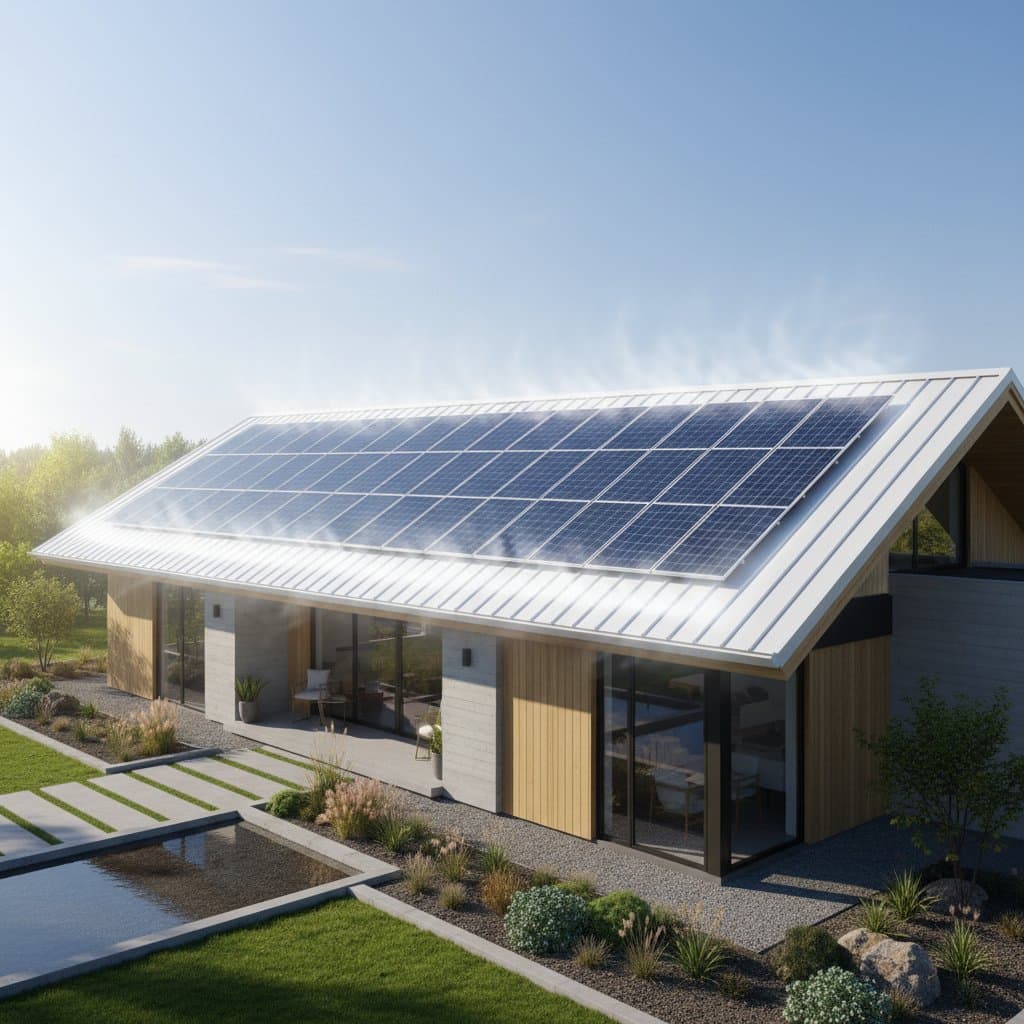Cool Roofs Enhance Solar Savings by 40 Percent in 2025
Solar research often feels overwhelming to homeowners. Many individuals recognize that sunlight powers solar panels, yet fewer understand how roof temperature influences panel efficiency. Excessive roof heat diminishes solar cell performance and increases the workload on home cooling systems. Cool roof technology alters this dynamic. In various climates, combining a reflective roof with a solar system can elevate overall energy savings by up to 40 percent.
Why Roof Temperature Influences Solar Performance
A dark roof absorbs sunlight and transforms much of it into heat. On a clear summer day, a conventional asphalt shingle roof can exceed 150 degrees Fahrenheit. This heat conducts into the attic and living areas, elevating indoor temperatures and extending air-conditioning runtime. Simultaneously, solar panels on a hot roof function less effectively. Each 10-degree rise above standard test conditions reduces panel output by approximately 4 to 5 percent.
Cool roofs employ reflective materials that redirect sunlight back into the atmosphere instead of absorbing it. This approach maintains cooler conditions for both the roof surface and the panels. Panels operating nearer to their optimal temperature generate more electricity from the same amount of sunlight.
The Mechanics of Cool Roof Technology
Cool roofs incorporate specialized coatings, membranes, or light-colored shingles designed to reflect solar radiation. The most effective options integrate two essential properties:
- High solar reflectance. The surface redirects a greater portion of the sun visible and infrared light.
- High thermal emittance. The surface dissipates any absorbed heat more rapidly into the surrounding air.
These characteristics reduce roof surface temperatures by 50 to 60 degrees compared to traditional materials. Such moderation fosters a stable setting for solar panels and prolongs their durability by minimizing thermal stress on cells, wiring, and mounting components.
Quantifying the 40 Percent Efficiency Gain
Examine a standard 7-kilowatt solar system on a dark shingle roof. In an area receiving about 1,300 kilowatt-hours of solar energy per installed kilowatt annually, the system produces roughly 9,100 kilowatt-hours each year. At an electricity rate of 18 cents per kilowatt-hour, the panels offset approximately 1,638 dollars annually.
On a cool roof that moderates panel temperatures, output increases by 5 to 8 percent. This improvement yields an extra 450 to 700 kilowatt-hours per year, valued at 80 to 125 dollars in additional generation. Factoring in air-conditioning reductions from cooler attics, total household energy savings can achieve 40 percent over a non-reflective roof without solar. The aggregate advantage stems from enhanced solar production and diminished cooling requirements.
Options for Installation and Materials
Not all roof types inherently qualify as cool. Homeowners have multiple material choices:
- Reflective asphalt shingles featuring specialized granules
- Single-ply membranes suited for flat or low-slope roofs
- Pigmented metal panels engineered for reflectivity
- High-reflectivity tiles or coatings
When reroofing prior to solar installation, selecting reflective materials incurs minimal additional expense. For existing structures, a reflective coating serves as an economical retrofit option. These coatings endure 10 to 15 years and can be refreshed alongside solar system maintenance.
Optimizing Cool Roofs in Solar System Design
Maximizing the interaction between roof and panels requires thoughtful design. Installers assess roof pitch, orientation, and shading to determine ideal placement. With a cool roof, flush-mounted panels avoid excessive heat accumulation beneath. Certain installations incorporate a modest ventilation gap between roof and modules to promote better airflow.
Reflective roofs further amplify bifacial solar panels, which harvest light from both surfaces. The luminous roof reflects sunlight onto the panel undersides, contributing an additional 2 to 3 percent to overall efficiency.
Financial Implications and Return on Investment
Upgrading to a cool roof generally adds 1 to 3 dollars per square foot to roofing costs. For a 2,000-square-foot home, this translates to 2,000 to 6,000 dollars initially. However, the resulting energy savings and prolonged roof longevity recoup this investment efficiently.
In the 7-kilowatt system scenario, combined solar gains and cooling reductions surpass 200 dollars yearly. Over 10 years, savings accumulate to 2,000 dollars, excluding potential rate hikes. If the reflective surface extends roof life by five years, future replacement expenses decrease accordingly. Payback typically occurs within seven to nine years, aligning with standard solar investment timelines.
Sustaining Performance Through Maintenance
Cool roofs demand minimal maintenance. Periodic rinsing eliminates dust and pollen that might impair reflectivity. During solar panel cleanings, inspect the roof for debris or fading. Most coatings retain effectiveness for over a decade prior to recoating. Regular cleaning of panels and roof ensures reliable output over time.
Homeowners contemplating solar should consult contractors on cool roofing during planning. Retrofitting post-installation remains feasible, though simultaneous implementation streamlines approvals and work.
Frequently Asked Questions
What defines a cool roof?
A cool roof reflects more sunlight and absorbs less heat than conventional materials, thereby maintaining cooler surfaces and attics.
Can any home incorporate a cool roof?
Yes, reflective variants exist for nearly all roof types, such as shingles, membranes, tiles, and metal panels.
By how much can a cool roof reduce temperatures?
It lowers surface temperatures by 50 to 60 degrees on sunny days, benefiting both indoor comfort and solar performance.
Do cool roofs impact winter heating expenses?
The effect proves negligible, as winter sunlight intensity and angles limit reflection benefits, making cooling advantages predominant.
How durable are reflective coatings?
Most endure 10 to 15 years before recoating is required.
